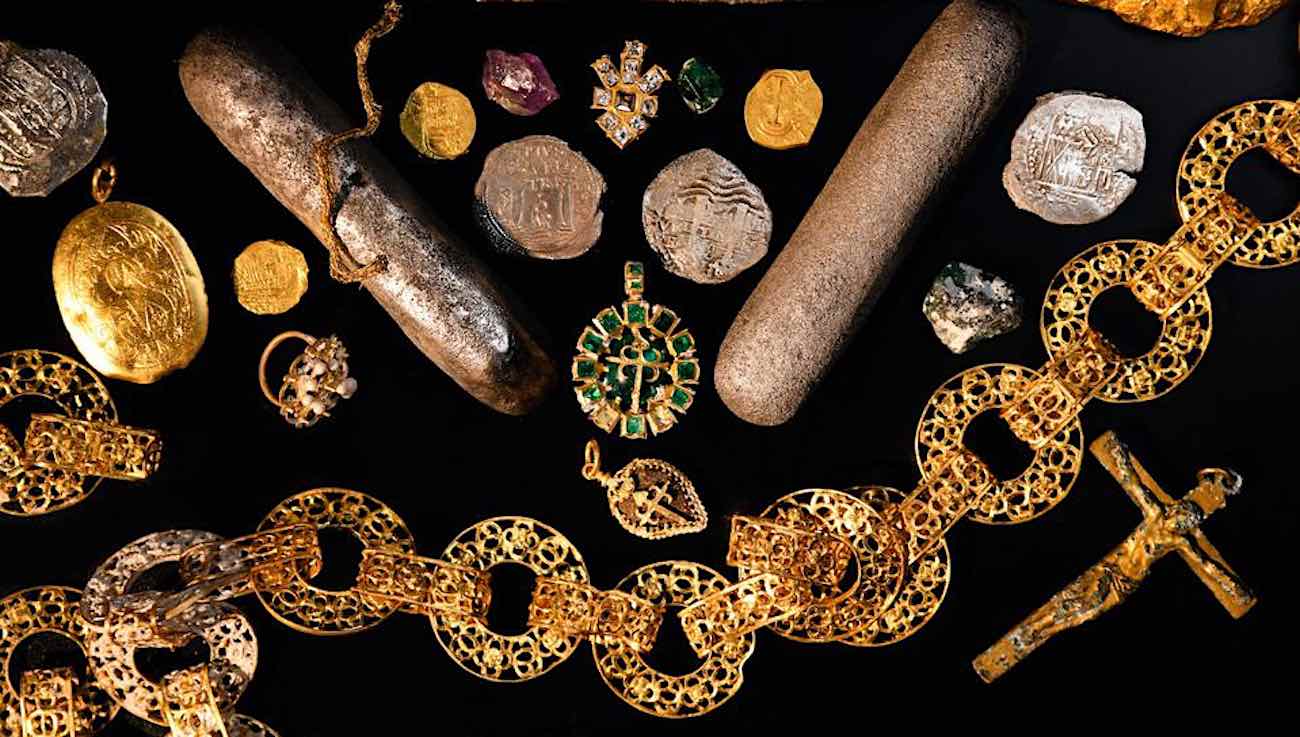A sunken crown jewel hidden in The Bahamas since 1656—the shipwrecked remains of the Spanish galleon Nuestra Señora de las Maravillas (Our Lady of Wonders)—goes on display this week for the first time.
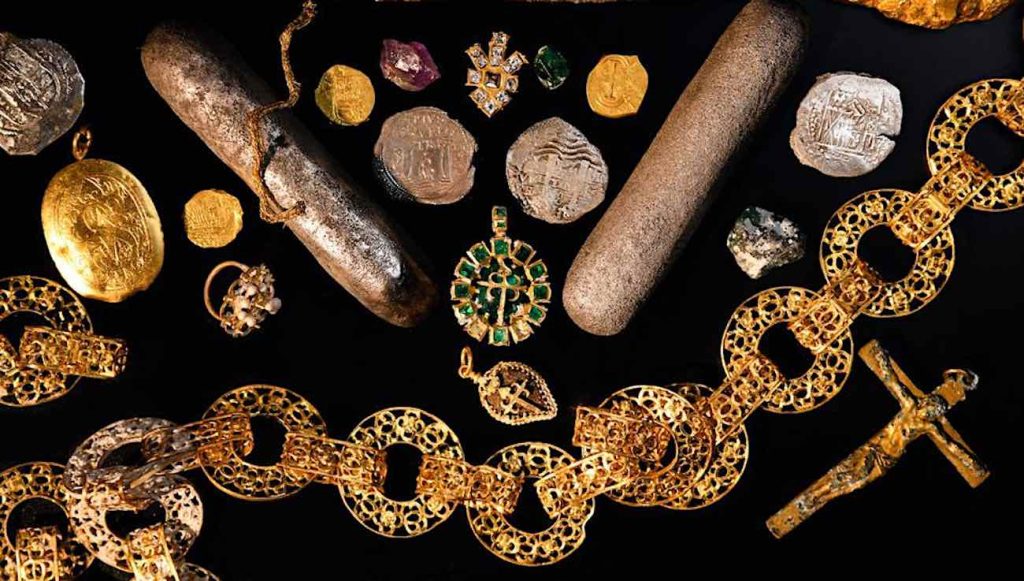
The huge ship was part of a fleet headed back to Spain from Cuba, loaded with royal and private consignments. Also onboard was a former Spanish cargo wrecked off Ecuador a year and a half earlier. The Maravillas ended up colliding with its fleet flagship, hitting a reef 30 minutes later and sinking.
Treasure-seeking divers from Allen Exploration are currently exploring a trail of debris left behind by the ship, uncovering remarkable finds. Along with Spanish olive jars, Chinese porcelain, iron rigging, and gold and silver coins, the team has discovered a silver sword handle that belonged to the soldier Don Martin de Aranda y Gusmán.
Three gold chains have been saved, as well as four pendants worn by members of the sacred Order of Santiago, a religious band of knights deeply active in Spanish maritime trade. All these finds are unique among the world’s three million shipwrecks. “The Maravillas is an iconic part of The Bahamas’s maritime history,” says Carl Allen, entrepreneur, explorer, philanthropist, and founder of AllenX. “Some say the remains were ground to dust (but) using modern technology and hard science, we’re now tracking a long and winding debris trail of finds.”
The company was licensed by the Bahamian government to explore the Maravillas scientifically and share its wonders with everyone by sponsoring the first maritime museum in The Bahamas.
“The galleon was stuffed with contraband illegally greasing the palms of Spanish merchants and officials,” said Allen. Because contraband was rampant, nobody knows what actually went down on the Maravillas. “That’s part of its legend.”
Two years of fieldwork has exceeded expectations: “Sparkling finds: olive jars, the spikes that held the Maravillas together, the odd cannon and anchors. And then there are the lucky strikes. Scatters of emeralds and amethysts mined in Colombia, not registered on the manifest, are tell-tale proof of contraband trafficking.”
RELATED: Legendary Spanish Galleon Shipwreck Discovered After Vanishing 300 Years Ago
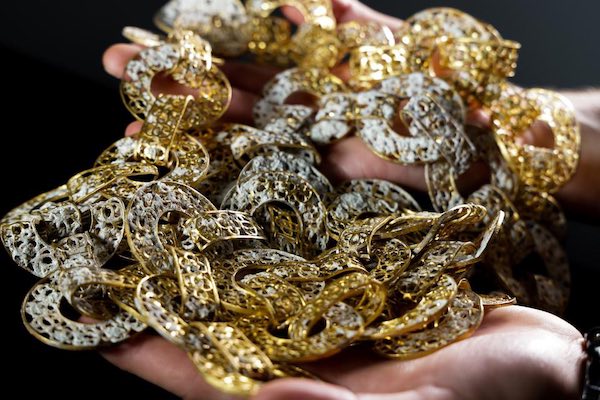
A stunning AllenX discovery is a 2-pound gold filigree chain (887 grams), 70 inches long, made up of 80 alternating circular flat and tubular links measuring 176 centimeters. They are decorated with four-lobed rosette motifs. No exact parallels exist from other excavations, in museum collections or are seen in Spanish portrait art. The Maravillas chain was intended for a wealthy aristocrat or even royalty. It was probably crafted in the Philippines from local gold, using Chinese craftsmen, and then exported to Spain by way of Mexico on a Manila galleon.
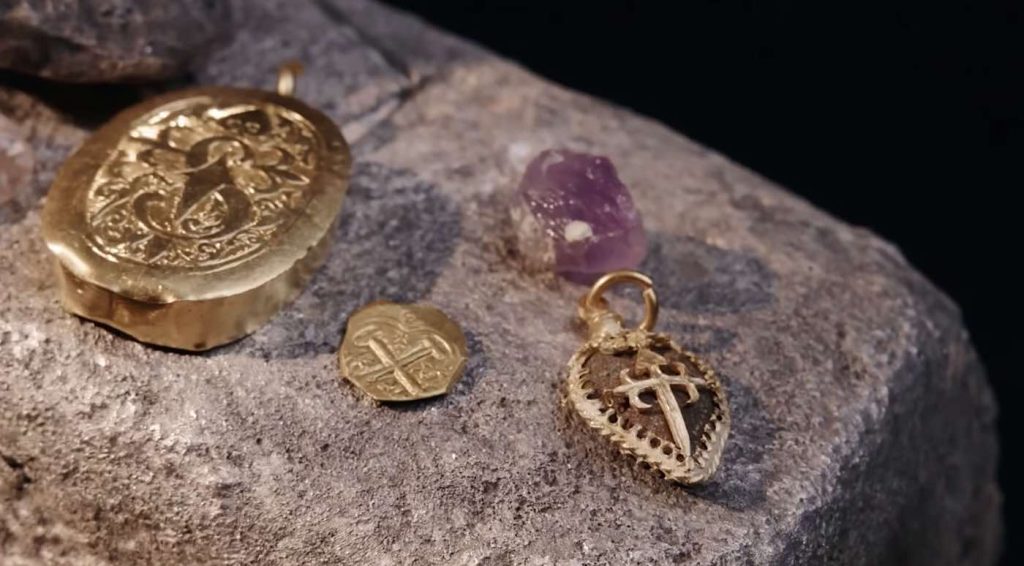
The star finds from AllenX’s exploration so far are the Order of Santiago jewels. A golden pendant with the Cross of Santiago (St. James) at its center, just 3.5 centimeters long, was designed in the form of a scallop shell. The pendant is reinforced on its back edge by what is seemingly an Indian bezoar stone, famous in Europe for its powerful healing properties.
(Scallops were picked up along the coast of Galicia and carried home by pilgrims who had visited the shrine of Santiago de Compostela, one of Europe’s most important pilgrimage centers, built by King Alfonso III in AD 899. The Basilica of St. James supposedly held the apostle’s bones. Knights of the Order of Santiago were charged since medieval times with protecting from attack the 800-kilometer pilgrim’s route stretching from the Pyrenees to Galicia.)
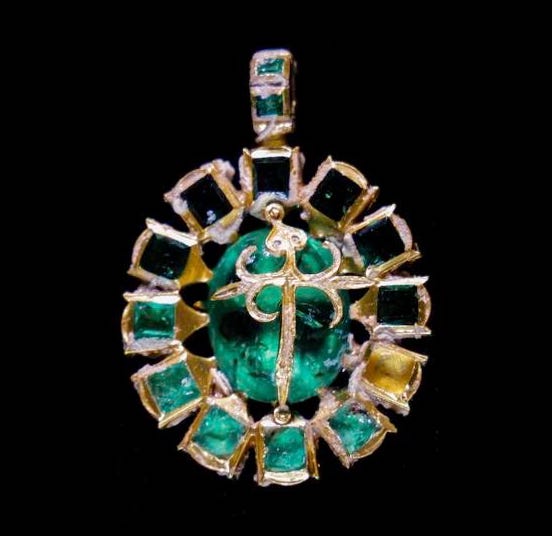
A second golden pendant found on the Maravillas’ debris trail is oval in shape and 1.7 inches long (4.7 cm). At its center a gold Cross of St. James overlies a large green oval Colombian emerald. The outer edge is framed by 12 more square emeralds, perhaps symbolizing the 12 apostles. To these can be added the team’s discovery of a 2.2-inch (5.3 cm) majestic oval gold locket with an elaborate cross of St. James framed by swirling foliage incised on the back, and a tiny golden cross, probably fallen out of another pendant. All these artworks were crafted to an exquisite standard and are again unique among excavated remains, museum collections and portrait art.
LOOK: Lake Michigan Is So Clear You Can See Shipwrecks From the Air
“When we brought up the oval emerald and gold pendant, my breath caught in my throat,” says Mr. Allen, who built a highly successful plastics business over 35 years. “I feel a greater connection with everyday finds than coins and jewels, but these Santiago finds bridge both worlds. The pendant mesmerizes me when I hold it and think about its history. How these tiny pendants survived in these harsh waters, and how we managed to find them, is the miracle of the Maravillas.”
Unlike former projects that had a commercial focus, Allen Exploration is committed to keeping its entire collection together for public display in The Bahamas Maritime Museum. Nothing is being sold. Quite the opposite. Carl Allen is buying back past shipwreck material to return it to The Bahamas.
While searching for the missing Maravillas, Allen Exploration has so far discovered around 18 wrecks. There are hundreds more on the Little Bahama Bank and thousands spread across The Bahamas.
POPULAR: Viking Age Shipyard Uncovered at Birka is Like Nothing Ever Found Before
The new exhibit opens on August 8, in Allen Exploration’s Bahamas Maritime Museum in Freeport, Grand Bahama. In 2016, Carl sold his companies and went pro with Allen Exploration, eventually buying Walker’s Cay in 2018, the nearest island to the wreck site of the Maravillas, which he is revitalizing as a must-see tourist destination.

Allen Exploration’s team, made up of marine archaeologists, operations’ directors and local Bahamian divers, has plotted over 8,800 magnetometer targets across a search area measuring around 7.5 x 5 miles (12 x 8 km). The finds fit the profile of personal property that drifted miles away from the central wreck on broken sections of the wooden hull.
The 891-ton capacity ship featured two decks and three bilge pumps. The superstructure included three cabins with two galleries, two poop decks, a chapel for mass and an upper cabin. The Maravillas cut through the waves protected with a fearless golden lion as a figurehead. Devotional oil paintings adorned the stern. The ship’s crew was composed of seven officers, 100 soldiers, 71 marines, 35 gunners, 30 seamen and 11 apprentice seamen.
LOOK: The Endurance Ship Wreck, Lost for 100 Years is Finally Found, 10,000-ft Below the Ice
The 1654 fleet reached Cartagena in August 1654, but the following year received orders to return rapidly to Spain, only to be heavily delayed again by a strong presence of English warships. On January 4, 1656, the Maravillas’ navigator realized the water depth was getting increasingly shallow. In the darkness, the flagship, the Nuestra Señora de la Concepción, tried to turn, but smashed into the side of the Maravillas’ bows. In less than 30 minutes after the collision, the Maravillas violently struck a reef and sank. Enormous waves broke the ship into pieces. The majority of the 650 people on the galleon were never to be seen again. By sunrise, only 45 people had survived.
In 1992 the Government of The Bahamas enacted a moratorium on the issuance of licenses for shipwreck salvage. The seas stayed closed until 2019, when Carl Allen was awarded a new license to conduct exploration of a scientific and archaeological nature. Allen Exploration submits monthly written scientific reports to the government, presenting aims and results, including illustrations, distribution maps of finds and lists of discoveries.
SHARE the Jewels and Mystery With Treasure Hunters on Social Media…




















